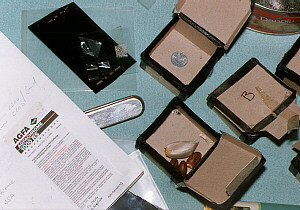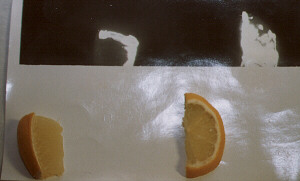|
|
The Online-Magazine
of the DATADIWAN
|
Issue Nr. 1 / March
1998 - ISSN 1435-1560
|
|
|
The Online-Magazine
of the DATADIWAN
|
Issue Nr. 1 / March
1998 - ISSN 1435-1560
|
| Summary:
Here an experiment conducted by Thema Moss is described which tried to reproduce life energy fields on photographic materials. Heretofore, mainly plant elements and photographic materials are placed together in an orgone accumulator based upon Wilhelm Reich’s orgone theory. In three series of tests, the set-up was reproduced in order to get actual pictures of life energy fields. The emergence of these pictures is analyzed and compared with casual physical and chemical effects. Keywords:
|
"Orgone energy field photographs can be made in a manner similar to that used to make Kirlian electrophotos, except that no electricity is needed," [DeMeo, English edition, pg. 98] asserts James DeMeo in his "Orgone Accumulator Handbook". He proceeds to introduce the technique of Thelma Moss, through which she apparently portrayed the life energy of plant elements, and continues by encouraging the reader to conduct the same experiment themselves.
Indeed this Experiment does not take much effort:
Place in an opaque box a piece of photographic paper together with the object one wishes to picture, and then place the closed box in the orgone accumulator. Wait awhile (DeMeo suggests anywhere from one to seven days). Develop the photographic paper. (However, DeMeo seems not to have conducted this experiment himself).
Picture 1 shows a few boxes and objects which Sigrid Bärndal and
Bernhard Harrer used in a test series in 1990.
 |
|
|
The Reproduction by Bärndal and Harrer of the Experiments Conducted
by Moss
In 1990 in a controlled environment, Bernhard Harrer and Sigrid Bärndal
conducted an experiment to expose photographic materials in an Orgone Accumulator.
Many different types of materials like sand, plant elements, metal, magnets, and tablets of highly potensified homoeopathic remedies) were placed together with highly sensitive film slides into light-proof metal or cardboard boxes. In the first series, the boxes were placed together with the control boxes, consisting of sensitive film slides with no special objects, for eight days into an orgone energy accumulator with nine double layers of iron and rock wool. In the second run, the boxes were placed for twelve days into the strongest orgone accumulator of a renown Berlin manufacturer (25 double layers). Afterwards, the film material was developed immediately.
The photographic materials used were Orwo UT 21 (ASA 100) in the first run, it was developed by Bärndal und Harrer. In the second experiment Agfachrom 1000 RS (ASA 1000) was used, and the development was carried out in a professional laboratory which pushed the sensitivity to ASA 2000. This specific type of film was chosen for the experiment, because Wilhelm Reich attributed a blue color to orgone energy. Color slide film reproduces unadulturated (pure) colors, is highly light sensitive, and if need be, the laboratory can double its sensitivity.
The Results of the First and Second Test Series
The piece of film which was stored in a humidity-proof box with a twig
from the Juniper plant showed green spots, especially where the twig had
been in direct contact with the film. On no other film was any evidence
of exposure to light found.
The results were weak; many different materials showed no image at all. However, the blossoming Juniper twig inspired us to conduct a third test. Could it be that a living, organic object like a Juniper twig or the slice of lemon which Moss used could trigger an effect? In any event, the piece of film that was placed together with the Juniper twig was moist and swollen after it was taken out of storage after twelve days in the orgone accumulator!
The Third Test
A third test should explain the phenomenon. Thelma Moss had placed
the lemon slices and meat directly on the film material. This we chose
to do again with lemon slices. And this time, we used simple black-white
negative papers with PE- and Baryt-Basis (Ilfospeed 3.1M PE-Paper and Foma
Baryt-Paper).
Indeed – the developed film showed changes which looked like possible
light exposure. In order to illustrate the effect, after having removed
the lemon pieces, we exposed half of the paper under an enlarger, and the
other half we covered up. Exactly where the lemon was placed on the photographic
paper, there appeared luminous spots. Where the skin of the lemon was still
intact, the effect was slightly less. Only a mild grey appeared. Picture
2 shows these images. The reexposed image in Picture 2 is the upper, black
part.
 |
| Copyright Picture 2: Bärndal and Harrer, 1992 |
It has nothing to do with the photographing of the life energy fields as Moss and DeMeo assert. Firstly, these are not really photographs at all, but rather they occur through a chemical reaction and not through an exposure to light. Secondly, there is no evidence that the orgone accumulator had any influence on the genesis of these pseudo-photos.
Moss reports in her book that back even then, critics told her that the phenomenon occured because of a direct chemical contact. She would not let this explanation carry any weight, because in some cases where spots were seen, no direct contact had occured.
How does this Phenomenon happen?
However, this occurance also can be conclusively proven. Organic material
continually gives off humidity and chemical substances, for example vapors
and etheric oils. If this was not so, we would not be able to smell a lemon;
they would never dry out; and a perfume bottle filled with pure lemon oil
would never be empty.
In a closed environment, the air and the substances will be quickly saturated with humidity, and the water and aromas will condense on the surface of the film. Have you ever asked yourself why an empty refrigerator should be kept open when it is turned off? Things begin to get moldy where there are organic substances on the surface.
The condensation on the surfaces is inconsistent, because the microscopic impurities act as condensation cores on which small drops precipitate. In the vicinity of the drops, the gas pressure (let this be water or etheric oils) due to physical reasons is so different that the drop can only grow to a specific size. In the cited experiments, it oozes into the photographic material and changes its characteristics, and even produces a chemical reaction. This is how we believe the spots described by Thelma Moss had occured. Exactly this is what our blossoming Juniper twig taught us.
| Berlin, February 8, 1998 |
Bernhard Harrer
|
Bibliography:
|
|